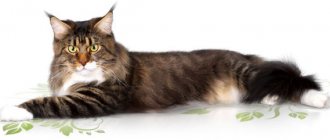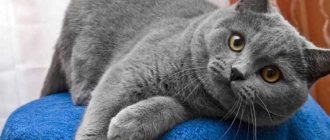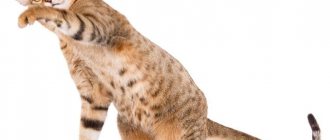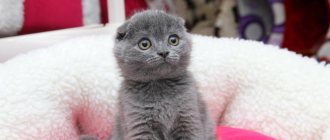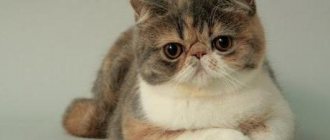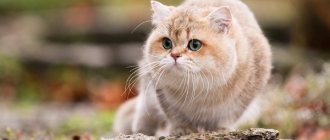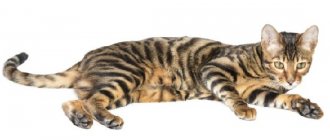The Celtic breed or European Shorthair cat was only recently recognized in the mid-twentieth century. The purpose of isolating this breed is to preserve the original appearance of ordinary domestic cats inhabiting the cities and suburbs of Europe. One of the most important advantages of these animals is their strong hunting qualities.
The first of those who began to breed European Shorthairs were breeders from countries such as Norway, Denmark and Sweden. Later, felinologists from France and Britain joined. In France today there are cats of blue color, called “tents”. In some countries, Celtic cats are called Carthusian. Breeders from England worked to breed large cats with a developed body, a round muzzle and dense fur. Later, it was from these cats that the beloved British breed originated.
It was only in 1982 that the Celtic cat breed was recognized as an independent breed. Now these cats, classified as shorthaired, hold the record for the number of variants of different colors. Only Oriental Shorthair and Persian cats can compete with them in this. They are one of the universal breeds that can live both in a city apartment and in a private home. At first, these cats may seem too simple, but their value lies in their naturalness.
Description of Celtic breed standards:
[advertising]
- the body has a medium size closer to large, developed muscles, flexibility, weight from 4 to 8 kg;
- a developed chest has a rounded shape;
- legs of medium length, strong and strong, paws large and oval;
- the tail is short, tapering at the tip;
- the head is wide, shaped closer to a triangle, with a straight nose and clear cheekbones;
- the neck is short and strong;
- the ears are not very large, rounded at the tips, sometimes with tassels, set wide apart and directed vertically;
- the eyes are round, expressive, wide open, the color matches the coat;
- The coat is short, dense, silky and shiny, and comes in many colors.
Origin story
Once upon a time there were yard cats in the world. They lived a very long time ago, crawled through garbage dumps in search of food, and caught rodents.
The smartest or luckiest sometimes ended up in human dwellings and continued to exist there, trying to repay food and shelter by killing mice and being smart.
Centuries passed, and yard cats hardly changed, either in appearance or in character. Independent animals perfectly adapted to the harsh conditions of survival on the street and were not very eager to be domesticated.
Breeders became interested in this independence, and by the end of the 20th century they developed a new breed, using as a basis yard cats - excellent hunters, famous for their unpretentiousness.
Lifespan
On average, Celts live from 15 to 17 years. However, the care of the owner plays a big role in this matter. The European Shorthair cat needs to be vaccinated like any other cat. They receive their first vaccinations at the age of 2–3 months. From 4 to 7 months, vaccination is not carried out, since in small Celts at this time, milk teeth are replaced by “adult” ones.
In addition to vaccinations, the health and life expectancy of a cat is influenced by the care of the owner. If a cat eats properly, spends a lot of time in an active state and is not attacked by germs and viruses, then it will live to old age. When I was little, my grandmother had a cat, Musya. She went outside every day, gave birth every year, and ate natural food specially prepared by her grandmother. At the age of 20, Musya looked like an old woman - her eyes seemed tired, her fur was faded, and her gait was heavy. And most of my current neighbors’ cats do not live to be 15 years old, although they are pampered and often shown to the veterinarian.
Some European cats live to be 18 years old, but this depends on how well they are cared for
Interesting Facts
The development of a new breed began almost simultaneously in Norway, Denmark and Sweden. A little later, England, Germany, and France joined this process.
And if the first three got a Celtic or Swedish domestic cat (in Sweden), then the second three called their creation a European (or British) shorthair cat. France went even further and gave its pets the name “chartreuse”.
Later, the United States got involved and developed its own breed, calling it the American Shorthair cat.
The confusion over the names was ended in 1982, when the breed standard was recognized and the name “Celtic” or “European Shorthair” was established.
The breed is not particularly popular among followers of fashionable cats, as it has the most ordinary appearance and independent character, which it will not fail to show to its owner.
But for connoisseurs of simplicity and reliability, these animals are simply irreplaceable.
A photo of a Celtic cat is practically no different from a photo of a simple street cat.
Education and physical activity
Representatives of the European Shorthair breed are intelligent, smart and independent. In the process of raising and communicating with a Celtic cat, you need to be respectful and patient. The animal is well versed in the intonations of the human voice.
Demandingness and affection, perseverance and consistency will help in raising an obedient and equal family member. Screaming and rough handling will make a neurasthenic out of the Celtic Shorthair.
To prevent your cat from damaging the furniture, you need to purchase a scratching post. The European Shorthair should be provided with a place for outdoor games and climbing. It is necessary to remove all objects that could break from horizontal surfaces. Wires from electrical appliances are supposed to be hidden from the Celtic cat.
The ideal option would be to purchase a special complex for cats. Pet stores have a large selection of interactive toys. Having fun with them, a European shorthair cat can keep itself busy for a long time.
Caring for a European cat
An animal of this breed does not require special care. The cat will wash smooth fur on its own, and tangles will not form, since the fur is too short for this. If desired, the cat can be brushed periodically, but this is not necessary.
The cat has good health and strong immunity.How to care
When describing the care of a representative of the Celtic cat breed, it is better to say briefly - this breed is “for the lazy.” There is practically no need to comb the skin.
Note!
Singapore cat: character, photo, price, breed description, reviews, how to buy, how to choose, maintenance, care and owner reviews
Scottish Straight: cat photo, kitten prices, breed description, character, reviews, maintenance and care, nutrition + interesting facts
Chausie - overview of the breed, character and breeding characteristics. Price for a kitten and tips for choosing a purebred cat (115 photos)
Bathing - well, if only once a year. Maybe even two. This is more than enough. With frequent water treatments, the skin may lose its shine.
The health of your pet also does not require any effort. However, experts insist on at least a minimum of vaccinations. But Celts rarely get sick, and this breed has no hereditary diseases at all.
They are completely undemanding when it comes to food. Like good hunters, they perfectly catch small rodents and birds. They can eat them too, but they prefer boiled meat to raw meat.
Like any cats, Celts are big fish lovers; they value milk, cottage cheese, and boiled eggs. They won’t refuse a vegetable side dish.
But it is better not to give them fatty foods, as well as smoked sausages. Such dishes will not be healthy for any cat (and for humans, so why be silent?). There should be at least a third of meat products in the diet, preferably half.
Celtic cat price
The cost of kittens depends on their pedigree and varies from 5,000 to 30,000 rubles. However, you need to be especially vigilant with this breed - instead of a purebred animal, you can easily buy an ordinary yard Murzik. In principle, no one will notice the difference.
The Celtic cat is a rather rare breed for Russia; not all breeders breed it, and to the question “Where to buy a Celtic cat” it is better to look for the answer on the Internet or check with any cat club.
Appearance
The Celtic breed has pronounced sexual dimorphism. Depending on the gender, the weight of cats ranges from 4 to 8 kg.
According to the approved standard, purebred representatives have:
- wide-set ears, rounded at the tips (tassels are allowed);
- large, rounded head with developed cheeks and a strong chin;
- rounded eyes, characterized by uniform color of the iris (amber, green and blue shades, as well as heterochromia, are acceptable);
- a distinct stop, characterized by a slight depression between the eyes;
- flexible body with developed muscles and a rounded chest;
- strong and strong paws, tapering at the base;
- tail of medium length with a rounded narrow tip and a wide base.
The Celts have a short and thick coat, distinguished by the shine and elasticity of the hairs.
The standard allows any colors except:
- chocolate;
- acromelanic (Siamese);
- lilac;
- cinnamon (red-brown).
- faun.
All of the listed colors are a consequence of mixing with other breeds, which is strictly prohibited.
Photo of a Celtic cat
Read here Asian Tabby: 100 photos, videos of the breed, its description and care tips from owners
Help the site, share with friends 
Diseases and breed defects
Perhaps this is one of the rare cat breeds whose body does not suffer from hereditary diseases . The immunity of the Celtic cat has been forged over centuries and has not been spoiled by the noble blood of other, often pampered breeds. The only source of danger for EKSH are considered to be infections that even a cat sitting in an apartment can pick up: bacteria/viruses enter the house along with clothes and shoes.
This is interesting! Vaccination is prohibited during the period of teeth change. In cats, the process begins at four months of age and is completed by 7 months.
The first vaccinations for kittens are given at 8 weeks (if the cat was not vaccinated before birth) or at 12 weeks (with prenatal vaccination). 10 days before immunization, kittens are dewormed.
Sterilization and castration
If the owner of the Celtic beauty does not plan to regularly produce offspring, the animal should be sterilized (cat) or neutered (male). This can be done when the European pet reaches the age of 8-9 months. The time for the operation must be chosen correctly: females should not be in heat, and males should not be in heat.
There is no need to be afraid of interference. If it is performed by an experienced specialist under anesthesia, it will not cause harm.
It is much more dangerous to regularly suppress the sexual instinct with hormonal drugs. If used frequently, they can cause irreversible changes in the body of a European cat.
Tumor and cystic formations often occur in the abdominal cavity. In this case, complex surgical intervention cannot be avoided, and the postoperative period will be difficult.
Basics of proper nutrition
Your four-legged friend's menu may include ready-made food or natural ingredients. If you choose the first option, make sure that the food contains at least 30% meat. It should not contain milk, sweet additives or offal. Always pay attention to the composition indicated on the package and the expiration date.
To read: Popular Labrador breed: characteristics of the pet
Buy food from trusted manufacturers or on the recommendation of breeders. Don’t take what is imposed on most consumers; don’t skimp on quality food for your pet.
If you want to provide your animal with natural nutrition, do not be lazy in purchasing fresh and healthy food for it. This is the guarantee of his health. The diet should be based on lean meat. It can be eaten raw , then more useful components are retained. It is allowed to give fish and offal. Stewed vegetables and fermented milk products are suitable additions. Give your cat vitamin supplements periodically.
It is advisable to feed on a schedule - at the same time. For kittens, 3-4 times a day is enough, and for adults – 1-2 times. Be sure to place a bowl of clean water nearby so that the animal can always quench its thirst.
Peculiarities
The history of the appearance of short-haired cats takes us back into the depths of time, 60 million years ago, to the miacids, the ancestors of all predators on Earth, including cats. Over time, the weight of the animal became smaller, and about nine million years ago, animals appeared that were somewhat similar to modern felines.
Today, short-haired cats include breeds of cats whose hair does not exceed 4.5 cm in length. When compared to human hair, wool has a more complex composition. The follicles of an animal contain two types of hair at once: guard hair, which makes up the fur, and down hair (undercoat). The guard (integumentary) can have different lengths, thickness and rigidity. The thickest and longest fibers are called guides.
A guard hair may emerge from one follicle, surrounded by a whole tuft of fluff. It always lies on top, covering the down, thereby saving the animal from frost and precipitation.
The density of the undercoat and guard hairs depends on the climatic conditions in which the cats live. Northern animals have much thicker and warmer fur, with a lot of fluff. In the south there live cats with short hair that fits tightly to the body. Selected animals brought confusion into the natural pattern. Today, there are species that have no undercoat at all (Burmese), or even wool (Don Sphynx).
Rexes, contrary to the straight guard coat created by nature, are endowed with a wavy mutation. And the type of fur “brush” (some sphinxes have) looks like hard twisted wire.
Necessary living conditions
The European Shorthair cat can adapt to almost any conditions, but to make it comfortable, you need to create a corner for rest and sleep. Some owners install a cat house or playground in their apartment, and if this is not possible, then at least a bed is needed. The cat’s “bedroom” should be located in such a corner of the room that when lying down she can see the whole room - this way she feels safe (but away from heating devices, otherwise problems with the fur will arise). To prevent your cat from damaging furniture, wallpaper or things with its claws, you need to take care of the scratching post.
Even before purchasing an animal, collect a “dowry” for the Celt. You will need bowls (for water and food separately), brushes, care products, nail clippers, tray, litter, etc. For the healthy development and growth of an animal, toys are needed (especially if we are talking about a kitten). Fortunately, cat entertainment is inexpensive and sold in every store.
I have a large basket at home that was once purchased to store a children's construction set. Now it is filled to the brim with cat balls, mice and bones. Every time a new kitten appears, it’s hard for me to resist making such purchases, but lately I’ve been trying to make toys myself. For example, I made a scratching post that you can play with. I put a pebble in a plastic Christmas ball and sealed the neck of the ball. I wrapped the whole thing with jute rope using a glue gun. The younger cat loves this thing: she chews it, sharpens her claws, and forgot about the sofa.
Celtic cats are playful and active, so they definitely need toys.
Kittens
A kitten of the European breed will be an ideal gift for your child. Special charm, a constant desire to play and move, irrepressible energy and friendliness - these are the very qualities that make European kittens the closest friends for kids and distinguish them from others. In addition, their unpretentiousness and developed intelligence somewhat reduce the minimum age at which a kitten can be purchased - this is 2.5–3 months.
In any case, they quickly get used to their new home and become attached to all family members. Once you look at these cute little lumps, you will always be captivated by their charm.
Breeders are constantly working to preserve and maintain the high breeding level of this breed. This is one of the main areas of work of each nursery, along with constant participation in exhibitions and shows.
We present to your attention photos of kittens of various colors, for a general idea about these cats.
If you decide to buy yourself a smooth-haired kitten of the European breed, look for a club that specializes in these cats.
The final price of a kitten in each nursery, as a rule, is negotiated separately, so you can choose a baby for yourself in accordance with your financial capabilities.


